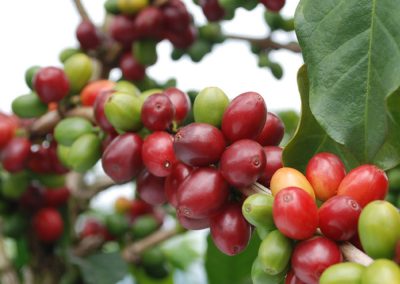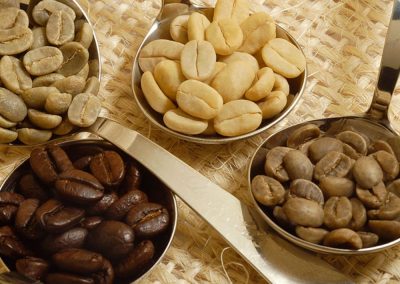Decaf
Coffees of any process (Washed, Natural, Honey, etc) can also be processed for decaffeination. The decaffeination itself takes place after the coffee has been harvested, processed, and had its parchment layer removed; most of the time, coffees need to be sent to specific facilities to be decaffeinated, rather than having the caffeine removed at the mill level.
At present, there is no such thing as a genetically decaffeinated coffee, which means that decaf coffee needs to be created by physically removing the caffeine from green coffee seeds. Most of today’s decaf processing methods are sophisticated and thorough and can remove 99 percent of the caffeine naturally present in coffee.
Many different techniques exist for decaffeinating coffee: Below, described briefly, are the types of decaf coffees that Cafe Imports sells.

Ethyl Acetate (E.A.) – This naturally occurring ester (present in bananas and also as a by-product of fermented sugars) can be isolated and used as a solvent to bond with and remove caffeine from green coffee. First, the coffee is sorted and steamed for 30 minutes under low pressure in order to open the coffee seeds’ pores and prepare them for decaffeination. The coffee is placed in a solution of both water and ethyl acetate, where the E.A. will begin to bond with the salts of chlorogenic acids inside the seeds. The tank will be drained and re-filled over the course of eight hours until caffeine is no longer detected. The seeds are steamed once more to remove the ethyl acetate traces, though E.A. is only harmful to humans in very high quantities (400 parts per million or more). The coffee is then dried and polished for export.
Learn more about the E.A. Decaf process here.
Mountain Water Process (MWP) – Our water-processed decafs are done in a facility in Mexico called Descamex. In order to remove the caffeine in this process, green coffee is soaked in a water solution, which removes both the caffeine as well as other solubles in the coffee (flavor compounds, for instance). The water is removed from the seeds and run through a special filter that captures caffeine molecules and allows them to be strained from the solution. The solution—now containing flavor compounds but no caffeine—is then reintroduced to the green coffee seeds, which reabsorb the soluble materials. The coffee is then dried once more, and prepared for reexport.
Methylene Chloride (MC) – Like in other decaffeination processes, methylene chloride is a solvent that is used to bond with and strip caffeine molecules from the green coffee seed. The KVW MC process first uses hot water to extract caffeine and other solubles from the coffee seeds, and then the seeds are removed from the water. Methylene chloride is then added to the water solution, and it bonds with the caffeine; because MC is not miscible with water, it is easily removed from the solution along with the bonded caffeine, and the coffee seeds are re-submerged in order to absorb their soluble compounds. The United States Food and Drug Administration has stated that MC is safe for use in decaffeination processes, and is harmless to humans in consumption of 10 parts per million (ppm) or less. Coffee decaffeinated using this method has been shown to contain a fraction of that safe amount.






